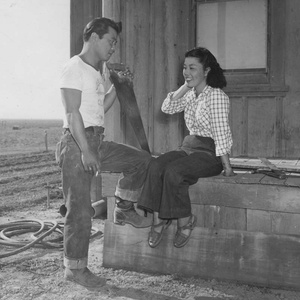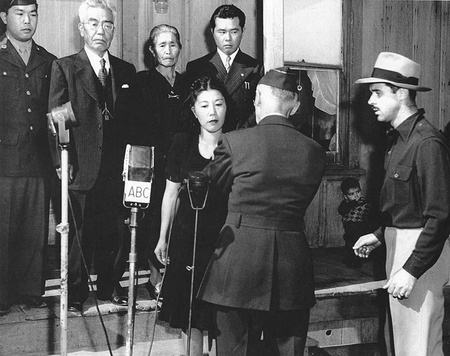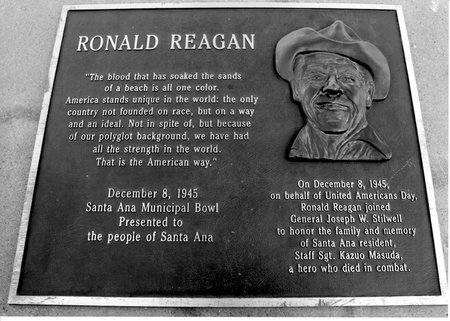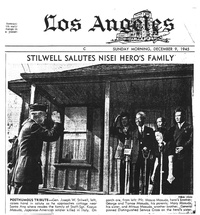Read part 4 >>
On December 18, 1944, the U.S. Supreme Court’s decision in the Endo v. the United States of America case unanimously determined that the government could no longer detain Japanese American citizens which the government had conceded as being loyal to the United States. This decision helped lead to the re-opening of the West Coast for resettlement by Japanese Americans in 1945.
However, many among the 80,000 still imprisoned in the War Relocation Authority camps were reluctant to return to their prewar West Coast communities because of reading reports and hearing rumors that told of terrorist and intimidation threats by irate home-front residents, some of whom were said to be employing dynamite and gunfire to back up their threats.

Outdoor Camp Photo of Mary Masuda talking to man holding a saw (Photo courtesy of Masao Masuda and Susan Shoho Uyehara, Japanese American Living Legacy/Nikkei Writers Guild)
But there were nonetheless a substantial number of Japanese Americans who refused to be intimidated. One of these was Mary Masuda. In the spring of 1945, she decided to leave the Gila River camp and travel to Talbert to check out local conditions there. She was surprised and dismayed to find that, while the Masudas were incarcerated or serving their country in the military, another Orange County family had moved into their vacant home and farmed their land without telling them about this situation or compensating them for the use of either the house or the land.
While she was visiting friends, an unidentified man telephoned and asked if Mary Masuda was there. When Mary answered, the man told her “she’d better go back to the concentration camp because Japanese Americans weren’t welcomed in Orange County.” Then, on the night of May 11, 1945, she was confronted at the door to the Masuda home by four or five visitors who said that they represented the Native Sons of the Golden West, and that they were “Patriots.” They told Mary that it would be in her best interests if they called a taxi for her return to Los Angeles, where she could catch a train to get her back to camp. They hinted that the road to Los Angeles wasn’t safe for Japanese.
The intimidation did not work. That night, Mary lay awake with this nagging thought: “I came this far, I must fight for what Kazuo and all of the rest of the soldiers fought for.” More determined than ever, Mary returned to the Gila River camp and in September 1945, in an act of extraordinary heroism, moved her family back to Talbert.
Two months later, on Saturday morning, December 8, 1945, in a simple ceremony on the porch of the Masudas’ small framed family home in Talbert, General Joseph “Vinegar Joe” Stilwell, a four-star general who had served as the commander of the China-Burma-India campaign, pinned a medal on Mary who, in turn, pinned it on her mother.

General Joseph Stilwell pinning DSC Medal on Mary Masuda (Photo courtesy of Masao Masuda and Susan Shoho Uyehara, Japanese American Living Legacy/Nikkei Writers Guild)
The medal was the Distinguished Service Cross, the second-highest military decoration that can be awarded to a member of the United States. It had been awarded posthumously to Kazuo Masuda for his gallant heroism and selfless devotion to duty and for exemplifying the highest traditions of the military forces of the United States.
Inspired by Mary Masuda’s noble actions, the War Relocation Authority used this ceremony, which was broadcast nationwide, to send out a message about the steep price that Japanese Americans had paid during the war to safeguard democracy and also to send a warning that anti-Japanese actions, such as those faced by Mary Masuda, would not be tolerated.
Instead of having a high ranking officer residing in the local Orange County community, which was the general practice for awarding posthumous medals, the U.S. Army dispatched a top-flight, big-name officer from Washington D.C. to perform the honors. For his part, General Stilwell, following the reading of the Army’s DSC Citation for Sergeant Kazuo Masuda, stepped forward and saluted the Masuda family and said, “It is an honor to be delegated to make this award.”

General Stilwell in Auto Caravan En route to Santa Ana Bowl (Photo courtesy of Masao Masuda and Susan Shoho Uyehara, Japanese American Living Legacy/Nikkei Writers Guild)
Moreover, following the medal presentation, General Stilwell participated later that same day in a rally in his honor staged at the Santa Ana Bowl by the Council for Civic Unity and all Santa Ana civic organizations.
Featured at this so-called “United America Day” rally, the theme for which was “American-All,” were representatives from an array of minority racial and ethnic groups plus a complement of Hollywood celebrities, including Louise Allbritton, Robert Young, and Will Rogers, Jr., who had attended the morning ceremony at the Masuda farm. It was Rogers who introduced Stilwell, who then declared: “Who, after all, is the real American? The real American is the man who calls it a fair exchange to lay down his life in order that American ideals may go on living. And judging by such a test, Sgt. Masuda was a better American than any of us here today.”
The featured speaker at the rally, who capitalized on its theme of racial unity, world peace, and domestic harmony, was the actor and Army captain Ronald Reagan, also a morning visitor to the Masuda farm. Following Pearl Harbor, when five Nisei produce clerks were fired from their jobs in Los Angeles as a “patriotic” gesture by the market’s owner, Reagan and his mother allegedly gathered the market’s customers together and won them over to an acceptance of the Nisei as Americans deserving fair play, and this action in turn inspired the market owner to reinstate his Nisei employees.
Now, in Santa Ana, Ronald Reagan delivered these stirring words: “Blood that has soaked into the sands of a beach is all one color. America stands unique in the world, the only country not founded on race, but in a way an ideal. Not in spite of, but because of our polyglot background, we have had all the strength in the world. That is the American way.”

Ronald Reagan Commemorative Plaque at Santa Ana Bowl (Photo courtesy of Masao Masuda and Susan Shoho Uyehara, Japanese American Living Legacy/Nikkei Writers Guild)
* This was a presentation at a public program in support of New Birth of Freedom: Civil War to Civil Rights in California at the Orange County Agricultural and Nikkei Heritage Museum, Fullerton Arboretum, California State University, Fullerton on October 19, 2011.
© 2011 Arthur A. Hansen






